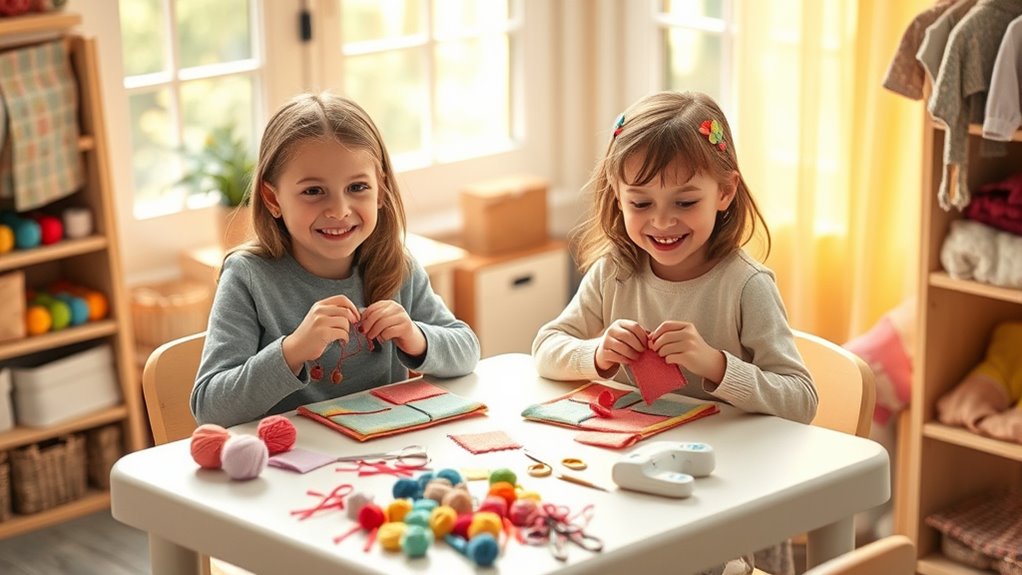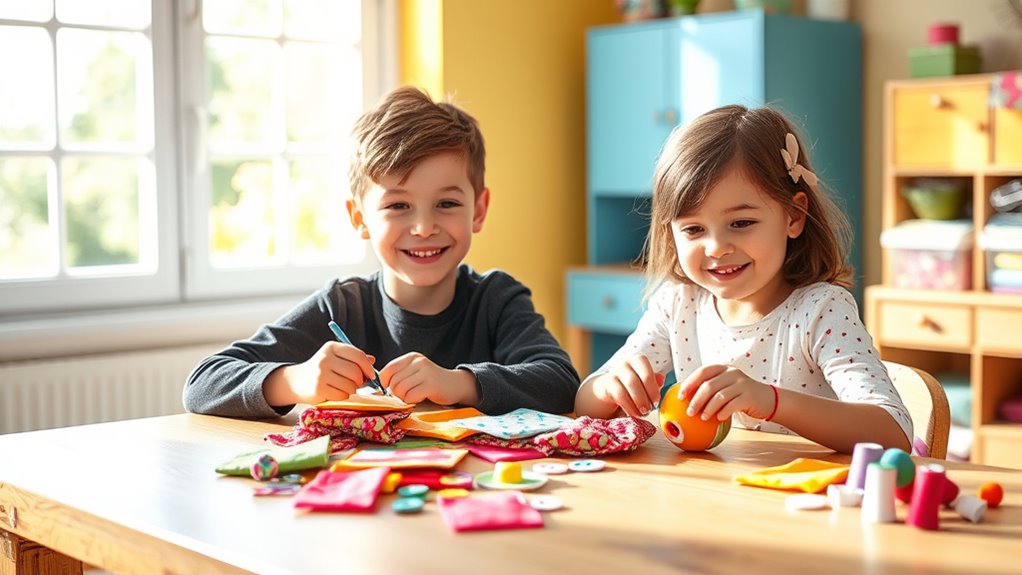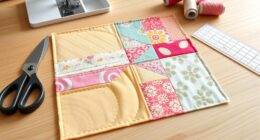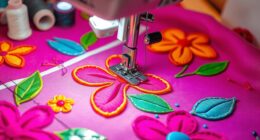When crafting with kids, choose simple, soft fabrics like cotton or felt that are easy to handle and safe for small hands. Engage them in selecting colors and patterns to boost enthusiasm. Supervise closely, use age-appropriate tools, and set clear boundaries to keep everyone safe. Safe, fun projects help children learn patience, improve fine motor skills, and build confidence. Keep exploring these ideas, and you’ll discover even more ways to make crafting a rewarding experience for your young creator.
Key Takeaways
- Select soft, lightweight fabrics like cotton for easy handling and safety for young children.
- Supervise closely and use age-appropriate tools such as blunt scissors to ensure safety during sewing activities.
- Involve kids in fabric and project choice to boost engagement and responsibility in the crafting process.
- Start with simple projects like sewing felt shapes or basic pillowcases to build foundational skills.
- Emphasize fun and patience to develop fine motor skills, creativity, and confidence through age-appropriate sewing activities.

Creating crafts with kids is a fun and rewarding way to encourage their creativity and develop new skills. When starting any sewing project, one of the first steps is choosing the right fabric. Fabric selection matters because it influences how easy the project will be for your child, how durable the finished item will be, and how enjoyable the process is. For young children, opt for soft, lightweight fabrics like cotton or felt, which are gentle on little hands and easy to work with. These materials are less likely to fray or cause frustration, making them ideal for beginner projects. As your child’s skills grow, you can introduce more textured or patterned fabrics, but always consider their comfort and safety first. Additionally, selecting fabrics with vibrant colors can boost your child’s enthusiasm and engagement with the project.
Choosing soft, lightweight fabrics like cotton or felt makes sewing fun and safe for kids.
Safety precautions are paramount when working with children on sewing projects. Always supervise their activities closely to prevent accidents, especially when using scissors, needles, or any sharp tools. Choose age-appropriate tools—such as blunt-tip scissors for younger kids—and teach them how to handle these items carefully. It’s also wise to keep needles and pins out of reach when not in use, and to remind your child to never put these tools in their mouth or hands. When sewing, ensure your workspace is clean and well-lit, so your child can focus and avoid mishaps. Additionally, teach basic safety rules, like how to properly thread a needle or tie a knot, emphasizing patience and caution.
Before you start, prepare a safe, organized area where your child can work comfortably. Keep all supplies within easy reach but away from clutter that could cause accidental injuries. Encourage your child to wear protective gear if necessary, like thimbles or finger guards, especially as projects become more complex. It’s also a good idea to set clear boundaries—such as no running or horseplay—during sewing sessions to keep everyone safe. As they gain confidence, you can gradually introduce more advanced techniques, but always prioritize safety first. Engaging your child in safety precautions helps foster responsible habits and confidence in their skills.
Involving children in fabric selection and safety precautions not only teaches them practical skills but also makes the craft more engaging. When they help choose the fabric, they feel more invested in the project. By emphasizing safety, you build their awareness and responsibility around handling tools and materials. This approach creates a positive, educational environment where your child can learn to sew confidently and safely, turning crafting time into a valuable experience that fosters patience, precision, and creativity.
Frequently Asked Questions
What Safety Precautions Are Recommended for Young Children Sewing?
When teaching young children to sew, you should prioritize safety by providing proper safety gear like child-friendly scissors and blunt needles. Always follow supervision guidelines, ensuring you’re nearby and attentive during their sewing activities. Teach them how to handle tools carefully and emphasize the importance of staying focused. By setting clear rules and maintaining constant supervision, you help create a safe environment that fosters their sewing skills while minimizing risks.
How Can I Introduce Sewing Concepts to Preschoolers?
Did you know that 85% of preschoolers enjoy hands-on activities? To introduce sewing concepts, start with simple projects like exploring different fabric textures to spark curiosity. Use easy sewing terminology, like “stitch” and “thread,” to build vocabulary. Keep sessions short, use large needles, and supervise closely. Focus on fun and discovery, helping your preschooler develop confidence and basic skills while making sewing a playful learning experience.
What Are Some Beginner-Friendly Sewing Projects for Tweens?
When choosing beginner-friendly sewing projects for tweens, focus on simple items like pillowcases, tote bags, or small pouches. Select easy-to-handle fabric, such as cotton or felt, and teach basic sewing stitches like running stitch and backstitch. Encourage their creativity by letting them pick colors and patterns, while guiding them step-by-step. This approach boosts their confidence, helps develop skills, and makes sewing an enjoyable, rewarding experience.
How Do I Choose Age-Appropriate Sewing Tools and Materials?
When choosing age-appropriate sewing tools and materials, consider fabric selection that’s soft, lightweight, and easy to handle for beginners. Opt for safety-first tools like blunt-tipped scissors and beginner-friendly needles. Always prioritize tool safety by supervising use and setting clear boundaries. Make sure the materials are suitable for your child’s age, ensuring they can handle the projects comfortably while learning new skills safely.
How Can I Encourage Creativity While Teaching Sewing Skills?
You can encourage creativity by letting kids explore fabric manipulation techniques like pleats or gatherings, which inspire unique designs. Encourage them to experiment with color coordination to develop their style and sense of harmony. Give them freedom to choose fabrics and patterns, then guide their ideas into sewing projects. This hands-on approach boosts confidence, sparks imagination, and helps them see sewing as a fun way to express themselves.
Conclusion
Now that you’ve explored age-appropriate sewing projects, remember that patience and practice are key. As the saying goes, “Rome wasn’t built in a day,” so celebrate small successes along the way. By encouraging creativity and perseverance, you help kids develop valuable skills and confidence. Keep the process fun and relaxed, and you’ll foster a love for crafting that lasts a lifetime. Happy sewing!









